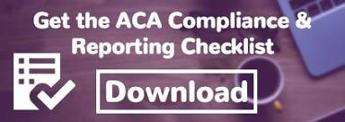
While the future of healthcare in America has been uncertain for most of this year, the ACA 2017 reporting deadline is right around the corner. After a year of back and forth, we’ve reached a point where we know not much can change on Capitol Hill between now and the looming 2018 deadline. To best manage and report on ACA compliance, there's a lot you need to know about the employer provisions that affect many U.S. employers.
As an HR manager, you need to know the ins and outs of these provisions so you can proactively manage ACA compliance in your organization. That starts with knowing your ACA vocabulary—what do all those acronyms mean anyway?
ACA terms for Human Resources
Affordable coverage: According to ACA provisions, your employer health plan must offer affordable coverage. An employer health plan offers affordable coverage as long as no employee pays more than 9.5% of their family income on premiums.
Administrative period: The administrative period is time for an employer to calculate the average hours worked by an employee during the measurement period to determine the employee’s benefits eligibility. The administrative period allows employers up to 90 days to complete the calculations (though you can complete this in minutes with an integrated HR system and ACA module). Most companies will align this with their open-enrollment period.
Applicable Large Employer (ALE): According to the IRS, an employer who has 50 or more full-time employees or full-time equivalent employees on average for the previous year is an ALE. ALE status updates each calendar year. ALEs are subject to the Employer Shared Responsibility and Reporting provisions of the ACA.
Consolidated Omnibus Budget Reconciliation Act (COBRA): Under certain qualifying events, a person may elect COBRA coverage. This mainly occurs when employment ends and former employees may temporarily keep the health coverage under the employer health plan. Another instance includes losing coverage as a dependent of a covered employee. When someone does elect COBRA coverage, they will pay 100% of the premium (including whatever share the former employer originally covered), plus an administrative fee.
Employer health plan: Also referred to as a job-based health plan, this is the coverage offered to an employee by his/her employer.
Employer shared responsibility and reporting: These are the ACA provisions that require all ALEs offer affordable healthcare coverage plans to eligible employees and their dependents. ALEs must also report these offers of coverage to the IRS and provide employees with similar information and statements. This is also referred to as the “employer mandate” or “pay or play provisions” referring to the financial consequences employers face for noncompliance.
Essential Health Benefits: These are the minimum requirements for benefits health insurance plans must cover. There are ten categories of essential health benefits:
- Ambulatory (outpatient) patient services
- Emergency services
- Hospitalization (like surgery and overnight stays)
- Pregnancy, maternity, and newborn care
- Mental health and substance use disorder services, including behavioral health treatment like counseling and psychotherapy
- Prescription drugs
- Rehabilitative and habilitative services and devices
- Laboratory services
- Preventive and wellness services and chronic disease management
- Pediatric services, including oral and vision care (note that adult dental and vision coverage are optional health benefits not required in health plans)
Form 1094-C: ALEs must use Form 1094-C to report required information about whether or not the employer offered affordable minimum essential health coverage (MEC) and enrollment in MEC for eligible employees. Form 1094-C will transmit forms 1095-C to the IRS.
The IRS will use Forms 1094-C and 1095-C to determine whether an employer will be penalized for noncompliance. This penalty will require payment under the Employer Shared Responsibility provisions under section 4980H. These forms will also determine employees’ eligibility for the premium tax credit.
Form 1095-C: This form provides important information employees need to complete their individual tax returns. On Line 61 of individual tax returns, employees must show whether they or their family members had minimum essential coverage. ALEs must prepare a Form 1095-C for each employee whose hours of service equaled 130 or more hours in a month. This even applies to those who did not take part in the employer-sponsored health plan. Employers must prepare a Form 1095-C for any part-time employee enrolled in the employer-sponsored plan. Employers do not need to prepare Form 1095-C for any part-time employees not enrolled in the employer-sponsored plan.
Form 8809: To apply for an extension to file information return forms with the IRS (like Form 1094-C), submit a Form 8809 on or before the due date of the return for an automatic extension. This form does not require a signature. For an additional 30-day extension, the filer or an authorized agent must sign the form.
Full-time Equivalent Employee (FTE): An employee is considered full-time equivalent if he/she worked (or expects to work) on average 30 hours or more a week for more than 120 days in a year.
Grandfathered Health Plan: A Grandfathered Health Plan is a health plan that already existed during the enactment of the Affordable Care Act in March 2010. Some grandfathered plans are exempt from certain ACA mandates. If your company's health plan is a grandfathered plan there are a few things to note:
- Changes to the plan that lie outside the permitted guidelines may cause your plan to lose its grandfathered status.
- Include a Notice of Grandfathered Status in annual health plan materials provided to employees. Any plan materials describing the benefits or health coverage must include a Notice of Grandfathered Status.
- Explain to your employees that the organization has a grandfathered plan.
- Provide enrolled employees with the proper contact information for questions or comments.
Measurement period: Also called the “look-back period,” the measurement period is the set period of time an employer records the hours worked by a variable hour employee. This measurement period must to be between three and 12 consecutive months (designated by the employer).
Minimum Essential Coverage (MEC): The minimum amount and type of health coverage individuals must obtain and report to the IRS. Individuals may receive this coverage through employers for themselves and their dependents. ALEs must provide MEC plans to eligible employees and their dependents, including COBRA and retiree coverage.
Minimum Value Coverage (MVC): Employer health plans must cover at least 60% of the total allowed cost of benefits expected to be incurred under the health plan.
Non-discriminatory coverage: Your employer health plan must offer fair and equal coverage to all eligible employees. Do not offer different eligibility or health benefits to any employees. This includes employee differences based on age, years of service, or compensation.
Stability period: Also called the “hold period,” the stability period is the period when employees who have been determined to be full time in the administrative period become eligible and must remain eligible for health coverage. This hold period allows employees to maintain the status determined in the measurement period for the designated amount of time in the stability period. The stability period can be between six and 12 months. With the exception of the first year, the stability period cannot be longer than the measurement period.
Is your company prepared to report on ACA compliance? Get the ACA Compliance and Reporting Checklist that will walk you through important steps for ACA management. Download the checklist now and be confident your ACA reporting doesn't land you with penalties from the IRS.

